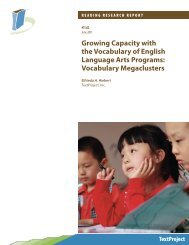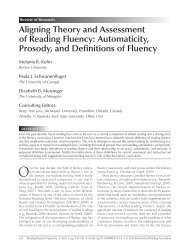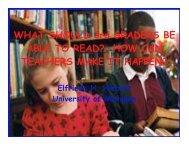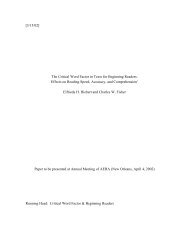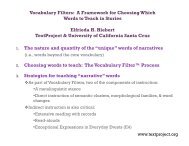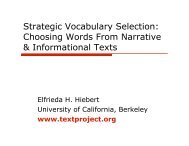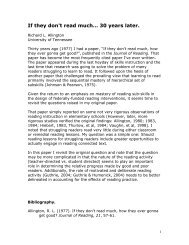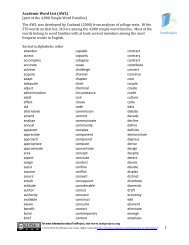word - TextProject
word - TextProject
word - TextProject
Create successful ePaper yourself
Turn your PDF publications into a flip-book with our unique Google optimized e-Paper software.
Which Words<br />
to Teach?<br />
Curriculum for<br />
Fluency &<br />
Vocabulary<br />
Elfrieda H. Hiebert<br />
University of<br />
California,<br />
Berkeley<br />
UCSIR (2005)
Definition of Reading<br />
Comprehension<br />
UCSIR (2005)
Which Words to Teach?<br />
Curriculum (Standards?) for Fluency and<br />
Vocabulary<br />
1.The “<strong>word</strong>” problem: Volume far<br />
outstrips the possibility that the<br />
pronunciation and meanings of all<br />
<strong>word</strong>s can be taught<br />
2.The <strong>word</strong>s with which students need<br />
to be fluent<br />
3.The <strong>word</strong>s that form the vocabulary<br />
curriculum<br />
UCSIR (2005)
1. The “<strong>word</strong>” problem: Volume far outstrips the<br />
possibility that the pronunciation and meanings of all<br />
<strong>word</strong>s can be taught<br />
5<br />
4<br />
3<br />
WordZones TM<br />
0-2<br />
UCSIR (2005)<br />
Zeno et al., 1995
Gr. 2--Mid Year (Nation’s Most Widely<br />
Used Reading Program)<br />
Hot oil sizzles, vegetables crackle, and<br />
woks clang and bang. The cooks shout to<br />
be heard. At the outdoor market I can<br />
barely move. But we go there because<br />
Grandma likes to buy fresh snapping<br />
crabs for dinner. When the crabs seem<br />
furious, Grandma is pleased. The angrier<br />
the crabs, the tastier the meat, she says.<br />
UCSIR (2005)
Gr. 2--Mid Year (Nation’s Most Widely<br />
Used Reading Program)<br />
Next the children are taken to see the<br />
dispatch room. Things are never slow here!<br />
It is busy all day and all night. Computer<br />
monitors flash. Telephone switchboards<br />
ring. It is here that phone calls come in,<br />
telling operators where the fires are.<br />
Some calls come from 911, the number<br />
many communities use for emergencies.<br />
UCSIR (2005)
Gr. 2--Mid Year (Nation’s Most Widely<br />
Used Reading Program)<br />
That night, after he put on his pajamas,<br />
Ricky went into the living room, where his<br />
father was listening to the radio. "Papi, I<br />
lost my mustache...mi bigote." His father<br />
laughed. "What mustache?" Ricky climbed<br />
into his father's lap and told him<br />
everything. His father smiled and told him<br />
a story.<br />
UCSIR (2005)
Gr. 4--Mid Year (Nation’s Most Widely<br />
Used Reading Program)<br />
Six hours after Mick and the team had left,<br />
Akiak padded softly, cautiously, into the<br />
checkpoint. Her ears alert, her wet nose<br />
sniffed the air. The team had been there,<br />
she could tell.<br />
Suddenly, cabin doors flew open. Five<br />
volunteers fanned out and tried to grab her.<br />
Akiak zigged around their every zag and<br />
took off down the trail.<br />
UCSIR (2005)
Gr. 4--Mid Year (Nation’s Most Widely<br />
Used Reading Program)<br />
Several days later, the Carpathia arrived<br />
in New York City harbor. Thousands of<br />
people waited in pouring rain to greet the<br />
survivors. Ruth heard cries of joy from<br />
the people who had found their loved<br />
ones. But many others looked sad as<br />
they searched for family and friends who<br />
had drowned.<br />
UCSIR (2005)
Gr. 4--Mid Year (Nation’s Most Widely<br />
Used Reading Program)<br />
He surrounded himself with songbirds, but<br />
he could not forget. Finally, when his<br />
daughter was nearly grown, he could wait<br />
no more. He took his family and returned<br />
to his homeland.<br />
Once again he saw the mountains and<br />
rivers of his childhood. They were just as<br />
he had remembered them. Once again he<br />
exchanged stories<br />
UCSIR (2005)
II. The Words With Which Students<br />
Need to be Fluent<br />
NAEP (Gr.4)<br />
<br />
<br />
<br />
Proficient & Above Basic Below Basic<br />
UCSIR (2005)
Fluency Problem and Solutions<br />
HUNGRY SPIDER<br />
AND THE TURTLE<br />
Spider was a hungry one,<br />
he always wanted to eat.<br />
Everybody in Ashanti<br />
knew about his appetite.<br />
He was greedy, too, and<br />
always wanted more than<br />
his share of things. So<br />
people steered clear of<br />
Spider. But one day a<br />
stranger came to Spider's<br />
habitation out in the back<br />
country.<br />
98<br />
96<br />
94<br />
92<br />
90<br />
Accuracy<br />
1 (low) 2 3 4 (High)<br />
UCSIR (2005)
Grade 4 Textbooks<br />
The fellow seemed confused about buttonholes and<br />
buttons. In the evening he joined the Baileys for dinner. The<br />
steam that rose from the hot food fascinated him. He<br />
watched Katy take a spoonful of soup and blow gently<br />
across it. Then he did exactly the same. Mrs. Bailey<br />
shivered.<br />
(from The Stranger, Houghton Mifflin, 2003)<br />
And directly between those forepaws, in the very jaws of<br />
his enemy, sat Tucker Mouse. He was watching Chester<br />
curiously. The cricket began to make frantic signs that the<br />
mouse should look up and see what was over him. Very<br />
casually Tucker raised his head.<br />
(from Cricket in Times Square, Harcourt, 2001)<br />
UCSIR (2005)
Gr. 4 Texts and Tests<br />
FCAT TAKS NAEP HM<br />
(Unit<br />
1)<br />
Quick<br />
Reads<br />
(D)<br />
5b 100 100 100 100<br />
5a 99 98 99.5 95 100<br />
4 91 92 93 82 98<br />
3 83 81 87 68 94<br />
0-<br />
2<br />
67 70 80 57 87<br />
UCSIR (2005)
Difficulty of Texts on Tests<br />
Grandpa looked at the picture silently for a moment.<br />
“When I was a boy, my father worked for the railroad in<br />
Canada,” he began. “His job was to take care of sections of<br />
railroad track in remote areas. The workers’ families lived<br />
along the tracks in small groups many miles from other<br />
towns or people.” (from TAKS, 2004)<br />
The red fox hurried back to her babies. One by one, she<br />
carried them under the fence, across the field, and through<br />
the hole in the barn wall. And when all three kits were<br />
snuggled down in the blanket of straw, she licked them and<br />
felt safe. (from FCAT, 2003)<br />
UCSIR (2005)
Text Difficulty: Assessments<br />
TAKS FCAT NAEP HM<br />
(Unit<br />
1)<br />
Quick<br />
Reads<br />
(D)<br />
5b 100 100 100 100<br />
5a 98 99 99.5 95 100<br />
4 92 91 93 82 98<br />
3 81 83 87 68 94<br />
0-<br />
2<br />
70 67 80 57 87<br />
UCSIR (2005)
Text Difficulty: Assessments<br />
FCAT TAKS NAEP HM<br />
(Unit<br />
1)<br />
Quick<br />
Reads<br />
(D)<br />
5b 100 100 100 100<br />
5a 99 98 99.5 95 100<br />
4 91 92 93 82 98<br />
3 83 81 87 68 94<br />
0-<br />
2<br />
67 70 80 57 87<br />
UCSIR (2005)
The texts that accounted for significant<br />
differences in the NRP sample<br />
Texts with controlled vocabulary were used in<br />
74% of the studies used in the meta-analysis.<br />
Of the four studies that used literature, only one<br />
reported a fluency outcome and, in that study,<br />
treatment and comparison groups did not differ<br />
significantly. That is: the effect size for fluency<br />
came from studies that used texts with<br />
controlled vocabulary.<br />
(Hiebert & Fisher, Elementary School Journal, 2005)<br />
UCSIR (2005)
A Fluency Curriculum<br />
Level A<br />
Level B<br />
Level C<br />
Level D<br />
Level E<br />
300 most frequent <strong>word</strong>s;<br />
short and long vowels<br />
500 most frequent <strong>word</strong>s;<br />
short, long and r<br />
controlled vowels<br />
1000 most frequent <strong>word</strong>s;<br />
all monosyllabic <strong>word</strong>s<br />
1000 most frequent <strong>word</strong>s;<br />
two syllable <strong>word</strong>s<br />
3000 most frequent <strong>word</strong>s<br />
UCSIR (2005)
Level B Texts (i.e., Gr. 2 curriculum)<br />
How Animals Communicate<br />
Animals don't talk, but they do communicate. When you<br />
communicate, you give information to others. Animals have<br />
ways of communicating that are different from the ways that<br />
people use. When your friend talks to you, your friend uses<br />
language to communicate information. In a language, each<br />
<strong>word</strong> means something.<br />
Animals do not use <strong>word</strong>s. They use sounds and<br />
signals. Birds sing and move their wings. Some animals<br />
move their tails. Other animals communicate by moving their<br />
bodies in other ways. Different sounds and signals help<br />
animals communicate with each other.<br />
UCSIR (2005)
Level D (i.e., Gr. 4 curriculum)<br />
CLIMATE ZONES<br />
A pattern of weather over a long time is called a climate.<br />
The earth has six major climate zones. The United States<br />
is large enough to include examples of all six climate<br />
zones.<br />
Patterns of temperature and rainfall vary from one climate<br />
zone to another. As a result, the clothes that people wear<br />
are quite different in different climate zones. People<br />
living in a tropical climate, like Hawaii, do not need coats.<br />
Temperatures are warm to hot in winter and summer. An<br />
umbrella can come in handy, though, because Hawaii's<br />
tropical climate gets heavy rains. In contrast, people<br />
living in a polar climate, like northern Alaska, need very<br />
warm coats for the snowy winters that last for much of<br />
the year.<br />
UCSIR (2005)
Difficulty: Texts and Tests<br />
FCAT TAKS NAEP HM<br />
(Unit<br />
1)<br />
Quick<br />
Reads<br />
(D)<br />
5b 100 100 100 100<br />
5a 99 98 99.5 95 100<br />
4 91 92 93 82 98<br />
3 83 81 87 68 94<br />
0-<br />
2<br />
67 70 80 57 87<br />
UCSIR (2005)
Level B Texts (i.e., Gr. 2 curriculum)<br />
How Animals Communicate<br />
Animals don't talk, but they do communicate. When<br />
you communicate, you give information to others. Animals<br />
have ways of communicating that are different from the<br />
ways that people use. When your friend talks to you, your<br />
friend uses language to communicate information. In a<br />
language, each <strong>word</strong> means something.<br />
Animals do not use <strong>word</strong>s. They use sounds and<br />
signals. Birds sing and move their wings. Some animals<br />
move their tails. Other animals communicate by moving their<br />
bodies in other ways. Different sounds and signals help<br />
animals communicate with each other.<br />
UCSIR (2005)
Text 2 of a Topic<br />
The Honeybee Dance<br />
One way honeybees communicate with each other is<br />
by dancing. Honeybees do a special dance after they find<br />
nectar in flowers. Honeybees need nectar to live. When<br />
honeybees find nectar, they fly home to tell the other bees<br />
where to find the nectar.<br />
A bee that finds nectar moves its wings very fast when<br />
it dances. The bee moves in a shape that looks like the<br />
number 8. The bee does the dance many times. After the<br />
dance, the other bees know where to find the flowers with<br />
nectar.<br />
UCSIR (2005)
UCSIR (2005)<br />
Text 3 of a Topic
UCSIR (2005)<br />
Text 4 of a Topic
UCSIR (2005)<br />
Text 5 of a Topic
Program of Research<br />
4<br />
3<br />
Content<br />
Text<br />
2<br />
Content<br />
Text<br />
1<br />
Literature<br />
Content<br />
Text<br />
Misc.<br />
Texts<br />
0<br />
Status<br />
quo<br />
Status<br />
quo<br />
Literature<br />
WCPM Gain per week<br />
Study 1 Study 2 Study 3<br />
UCSIR (2005)
Study 4: 24-Week Intervention:<br />
Number of Words Read with<br />
meaning on a silent maze passage<br />
70<br />
60<br />
50<br />
40<br />
30<br />
Science<br />
Narrative<br />
20<br />
10<br />
0<br />
Begin<br />
End<br />
UCSIR (2005)
3. The <strong>word</strong>s that form the<br />
vocabulary curriculum<br />
UCSIR (2005)
CA: Of 3 reading standards:<br />
1.0 Word Analysis, Fluency, and Systematic Vocabulary<br />
Development<br />
Word Recognition<br />
1.2 Apply knowledge of <strong>word</strong> origins, derivations, synonyms,<br />
antonyms, and idioms to determine the meaning of <strong>word</strong>s and<br />
phrases.<br />
Vocabulary and Concept Development<br />
1.3 Use knowledge of root <strong>word</strong>s to determine the meaning of<br />
unknown <strong>word</strong>s within a passage.<br />
1.4 Know common roots and affixes derived from Greek and<br />
Latin and use this knowledge to analyze the meaning of<br />
complex <strong>word</strong>s (e.g., international).<br />
1.5 Use a thesaurus to determine related <strong>word</strong>s and concepts.<br />
1.6 Distinguish and interpret <strong>word</strong>s with multiple meanings.<br />
UCSIR (2005)
TX: Of 9 reading standards<br />
• (6) Reading/<strong>word</strong> identification.<br />
The student uses a variety of<br />
<strong>word</strong> recognition strategies. The<br />
student is expected to:<br />
(A) apply knowledge of lettersound<br />
correspondences,<br />
language structure, and context<br />
to recognize <strong>word</strong>s (4-8);<br />
(B) use structural analysis to<br />
identify root <strong>word</strong>s with prefixes<br />
such as dis-, non-, in-; and<br />
suffixes such as -ness, -tion, -<br />
able (4-6); and<br />
(C) locate the meanings,<br />
pronunciations, and derivations<br />
of unfamiliar <strong>word</strong>s using<br />
dictionaries, glossaries, and<br />
other sources (4-8).<br />
(9) Reading/vocabulary development. The<br />
student acquires an extensive<br />
vocabulary through reading and<br />
systematic <strong>word</strong> study. The student is<br />
expected to:<br />
(A) develop vocabulary by listening to<br />
selections read aloud (4-8);<br />
(B) draw on experiences to bring meanings<br />
to <strong>word</strong>s in context such as interpreting<br />
figurative language and multiplemeaning<br />
<strong>word</strong>s (4-5);<br />
(C) use multiple reference aids, including a<br />
thesaurus, a synonym finder, a<br />
dictionary, and software, to clarify<br />
meanings and usage (4-8);<br />
(D) determine meanings of derivatives by<br />
applying knowledge of the meanings of<br />
root <strong>word</strong>s such as like, pay, or happy<br />
and affixes such as dis-, pre-, un- (4-8);<br />
and<br />
(E) study <strong>word</strong> meanings systematically<br />
such as across curricular content areas<br />
and through current events (4-8).<br />
UCSIR (2005)
Peabody Picture Vocabulary Test:<br />
Distribution of Word Zones (Gr. 4)<br />
45<br />
40<br />
35<br />
30<br />
25<br />
20<br />
15<br />
10<br />
5<br />
0<br />
% of 4th grade sample<br />
0-2<br />
3<br />
4<br />
5<br />
6<br />
UCSIR (2005)<br />
*Based on first appearing <strong>word</strong> of morphological family
attention<br />
discovered<br />
Current Direct Instruction:<br />
Words “Taught” in HM Gr2/Unit 4<br />
accept<br />
accident<br />
advantage<br />
argument<br />
audience<br />
colonies<br />
commands<br />
electrical<br />
enormous<br />
expression<br />
guarded<br />
nearby<br />
officer<br />
safety<br />
stared<br />
tending<br />
dim<br />
experts<br />
herd<br />
horizon<br />
imagination<br />
log<br />
obeys<br />
stiff<br />
tropical<br />
tunnels<br />
weaver<br />
antennae<br />
applauded<br />
banner<br />
carpenter<br />
cocoons<br />
fastening<br />
fungus<br />
larvae<br />
munching<br />
penalty<br />
pity<br />
puddle<br />
quarrel<br />
sawdust<br />
stalks<br />
aphids<br />
jeered<br />
parasol<br />
swivel<br />
teamwork<br />
news team<br />
UCSIR (2005)
Direct Instruction of Words:<br />
Criteria for Selecting<br />
1. Sufficient frequency to be useful<br />
2. Morphological families<br />
3. Complex meanings (Unknown &<br />
Polysemous)<br />
4. Semantic connections<br />
5. Spanish cognates<br />
6. Themes<br />
UCSIR (2005)
1. Frequency<br />
5<br />
4<br />
3<br />
WordZones TM<br />
0-2<br />
UCSIR (2005)<br />
Zeno et al., 1995
Frequency, “Knowness,”<br />
Morphological Richness (Hiebert, 2005)<br />
Total<br />
Words<br />
Morphological<br />
Morphological<br />
families<br />
of 2+<br />
over<br />
Knowness:<br />
NO<br />
Carry-<br />
Zone-<br />
Focus<br />
Words<br />
Zone 1<br />
203<br />
160<br />
124<br />
49<br />
8 (Z2)<br />
40<br />
1 (Z3)<br />
Zone 2<br />
620<br />
231<br />
221<br />
76<br />
18 (Z3)<br />
86<br />
Zone 3<br />
1676<br />
840<br />
612<br />
250<br />
20 (Z2)<br />
225<br />
24 (Z4)<br />
Zone 4<br />
2980<br />
1233<br />
332<br />
163<br />
187<br />
UCSIR (2005)
2. Morphologically rich<br />
Prefixes (account for 62%<br />
of all prefixed <strong>word</strong>s)<br />
un-, re-, in/im/il/ir (not), dis-,<br />
non-<br />
Suffixes (account for 76%<br />
of all suffixed <strong>word</strong>s)<br />
-s, -es, -ed, -ing, -ly, er/or<br />
(agent)<br />
(White, Sowell, & Yanagihara, 1989)<br />
UCSIR (2005)
Frequency, Morphological Richness (Hiebert, 2005)<br />
Total<br />
Words<br />
Morphological<br />
of 2+<br />
Carryover<br />
Knowness:<br />
NO<br />
Zone-<br />
Focus<br />
Words<br />
Zone 1<br />
203<br />
124<br />
49<br />
8 (Z2)<br />
40<br />
1 (Z3)<br />
Zone 2<br />
620<br />
221<br />
76<br />
18 (Z3)<br />
86<br />
Zone 3<br />
1676<br />
612<br />
250<br />
20 (Z2)<br />
225<br />
24 (Z4)<br />
Zone 4<br />
2980<br />
332<br />
163<br />
187<br />
UCSIR (2005)
3. Complex meanings<br />
• Graves (2000) identifies three types of <strong>word</strong>-learning<br />
tasks :<br />
• Words that are synonyms for <strong>word</strong>s that students already know,<br />
such as dim;<br />
• Words that students know at some level but that have multiple<br />
meanings, such as attention, channel, and practice; and<br />
• Words that represent concepts that may be new to students,<br />
such as liberty, biome, and probability.<br />
UCSIR (2005)
Frequency, Morphological Richness,<br />
“Knowness” (Hiebert, 2005)<br />
Total<br />
Words<br />
over<br />
Morphological<br />
of 2+<br />
NOT<br />
Known<br />
Living Word<br />
Voca.<br />
Carry-<br />
Zone-<br />
Focus<br />
Words<br />
Zone 1<br />
203<br />
124<br />
49<br />
8 (Z2)<br />
40<br />
1 (Z3)<br />
Zone 2<br />
620<br />
221<br />
76<br />
18 (Z3)<br />
86<br />
Zone 3<br />
1676<br />
612<br />
250<br />
20 (Z2)<br />
225<br />
24 (Z4)<br />
Zone 4<br />
2980<br />
332<br />
163<br />
187<br />
UCSIR (2005)
Zone 1<br />
Zone 2<br />
Frequency, Morphological Richness,<br />
“Knowness” (Hiebert, 2005)<br />
Total<br />
Words<br />
203<br />
620<br />
over<br />
Morphological<br />
of 2+<br />
124<br />
221<br />
NOT<br />
Known<br />
49<br />
76<br />
Carry-<br />
8 (Z2)<br />
1 (Z3)<br />
18 (Z3)<br />
Zone-<br />
Focus<br />
Words<br />
40<br />
86<br />
Zone 3<br />
1676<br />
612<br />
250<br />
20 (Z2)<br />
225<br />
24 (Z4)<br />
Zone 4<br />
2980<br />
332<br />
163<br />
187<br />
UCSIR (2005)
Word<br />
Zone/<br />
Grade<br />
Words<br />
within<br />
Zone/Grade<br />
1 body<br />
important<br />
form<br />
believe<br />
example<br />
2 nature<br />
scientists<br />
behavior<br />
considered<br />
section<br />
3 defense<br />
express<br />
sample<br />
style<br />
managed<br />
4 exposed<br />
minor<br />
tense<br />
associated<br />
merchandise<br />
UCSIR (2005)
4. Semantic connections<br />
• 7,230 “elementary school <strong>word</strong>s” fit into<br />
61 instructional clusters (Marzano &<br />
Marzano, 1988)<br />
UCSIR (2005)
dicovered,<br />
discovers,<br />
discovering<br />
cover,<br />
recover<br />
discover (2nd<br />
grade)<br />
discover<br />
find (for the<br />
first time)<br />
find out<br />
learn<br />
know<br />
understand<br />
discoverer<br />
discoverable<br />
(adjective)<br />
discovery<br />
realize<br />
detect<br />
analyze<br />
trick<br />
confuse<br />
UCSIR (2005)
5. Spanish cognates<br />
Greek<br />
(and others)<br />
Specialized <strong>word</strong>s<br />
used mostly in<br />
science<br />
Romance<br />
Technical, sophisticated <strong>word</strong>s<br />
used primarily in more formal<br />
settings such as literature and<br />
textbooks<br />
Anglo-Saxon<br />
Common, everyday, down-to-earth <strong>word</strong>s and<br />
frequently in ordinary trade books and found<br />
in school primers.<br />
UCSIR (2005)<br />
(from Calfee & Drum, 1981)
10 Common English Words & Their Latin and Spanish Equivalents<br />
English common <strong>word</strong><br />
Examples of English<br />
literary/academic <strong>word</strong>s<br />
Latin root<br />
Spanish common <strong>word</strong><br />
brave valiant, valorous, valor valere (to be strong) valiente<br />
bug<br />
insect, insecticide, insectum<br />
insecto<br />
insectivore<br />
dig<br />
cavern(ous), cave, cavus (hollow)<br />
excavar<br />
cavity, excavate<br />
empty vacant, vacate, vacancy vacare (to be empty) vacía<br />
enough<br />
sufficient, suffice, sufficiere (to provide) suficiente<br />
sufficiency<br />
first<br />
prime, primate, primal, primus (first)<br />
primero<br />
primacy, primary,<br />
primer, primitive<br />
mean significance, significant significans (meaning) significar<br />
moon<br />
lunar, lunacy, lunatic, luna (moon)<br />
luna<br />
lunation<br />
sell vendor, vend, venal venus (sale) vender<br />
wash lather, lavatory lavare (to wash) lavar<br />
Adapted from Kamil & Hiebert (in press).<br />
UCSIR (2005)
A Sample of<br />
ZONE 2 (Gr. 2)<br />
Words<br />
agree<br />
appear<br />
attack<br />
behavior<br />
certain<br />
charge<br />
choosing<br />
community<br />
company<br />
connected<br />
considered<br />
continued<br />
danger<br />
describe<br />
design<br />
developed<br />
difficult<br />
direction<br />
discovered<br />
distance<br />
education<br />
energy<br />
equal<br />
exercise<br />
experience<br />
concordar<br />
parcecer<br />
atacar<br />
conducta<br />
cierto<br />
carga<br />
escoger<br />
comunidad<br />
compañía<br />
conectar<br />
considerar<br />
continuar<br />
peligro<br />
describir<br />
diseño<br />
desarrollar<br />
difícil<br />
direccíon<br />
descubrir<br />
distancia<br />
educacíon<br />
energía<br />
igual<br />
ejercicio<br />
experiencia<br />
UCSIR (2005)
Thematic Vocabulary<br />
ocean<br />
habitat<br />
decomposition,<br />
decomposing<br />
organism<br />
Shoreline<br />
composition<br />
compose<br />
erosion<br />
beach<br />
survive<br />
erode<br />
survival<br />
UCSIR (2005)<br />
© Seeds of Science/Roots of Reading
Picture Vocabulary Results<br />
N<br />
Mean<br />
Pre<br />
Mean<br />
Post<br />
Effect<br />
Size<br />
Post<br />
Shoreline Seeds-Roots 342 4.71 5.60 .40<br />
GEMS 148 4.53 5.07<br />
Terrarium Seeds-Roots 342 3.12 3.53 .22<br />
GEMS 148 3.10 3.33<br />
Significant differences in favor of the S&R intervention<br />
for both, but marginal on Terrarium items<br />
UCSIR (2005)<br />
from Pearson, Cervetti, Hiebert, Arya, & Bravo, May 2005
Vocabulary (Semantic<br />
Associations): Results<br />
Significant effects on both taught (shoreline) and<br />
not taught (terrarium) vocabulary, but the effect<br />
size is nearly double for the taught vocabulary.<br />
N<br />
Mean<br />
Pre<br />
Mean<br />
Post<br />
Effect<br />
Size<br />
Post<br />
Shoreline Seeds-Roots 342 8.62 12.98 .57<br />
GEMS 147 8.64 10.49<br />
Terrarium Seeds-Roots 342 2.80 3.81 .30<br />
GEMS 147 2.88 3.35<br />
UCSIR (2005)<br />
from Pearson, Cervetti, Hiebert, Arya, & Bravo, May 2005
Applying “Principled” Vocabulary Selection<br />
to the Texts of Basal Reading Programs<br />
attention<br />
discovered<br />
accept<br />
accident<br />
advantage<br />
argument<br />
audience<br />
colonies<br />
commands<br />
electrical<br />
enormous<br />
expression<br />
guarded<br />
nearby<br />
officer<br />
safety<br />
stared<br />
tending<br />
dim<br />
experts<br />
herd<br />
horizon<br />
imagination<br />
log<br />
obeys<br />
stiff<br />
tropical<br />
tunnels<br />
weaver<br />
antennae<br />
applauded<br />
banner<br />
carpenter<br />
cocoons<br />
fastening<br />
fungus<br />
larvae<br />
munching<br />
penalty<br />
pity<br />
puddle<br />
quarrel<br />
sawdust<br />
stalks<br />
aphids<br />
jeered<br />
parasol<br />
swivel<br />
teamwork<br />
news team<br />
UCSIR (2005)
Words THAT SHOULD BE Taught DEEPLY<br />
in HM Gr2/Unit 4<br />
attention*<br />
discovered*<br />
formed<br />
groups<br />
noticed<br />
replied<br />
accept*<br />
advantage*<br />
allowed<br />
argument*<br />
commands*<br />
department<br />
expression*<br />
guarded*<br />
officer/official*<br />
tending*<br />
creature<br />
experts*<br />
horizon*<br />
UCSIR (2005)
accept* accepted acceptable acceptance<br />
advantage* advantages<br />
allowed allow allows allowing<br />
argument* arguments argued argue<br />
attention* attend attended<br />
commands* commander command<br />
creature creatures<br />
department departments<br />
discovered* discover discovery discoveries<br />
experts* expert<br />
expression* expressed expressions express<br />
formed form forms forming formation<br />
groups group grouped<br />
guarded* guard guards<br />
horizon* horizontal<br />
noticed<br />
notice<br />
officer/official* officers offices officials office<br />
replied<br />
reply<br />
tending* tends tended tendency tend<br />
UCSIR (2005)
Which Words to Teach?<br />
• The “<strong>word</strong>” problem: Volume far<br />
outstrips the possibility that the<br />
pronunciation and meanings of all<br />
<strong>word</strong>s can be taught<br />
• The <strong>word</strong>s with which students need to<br />
be fluent<br />
• The <strong>word</strong>s that form the vocabulary<br />
curriculum<br />
UCSIR (2005)
For more<br />
information:<br />
www.textproject.org<br />
UCSIR (2005)





